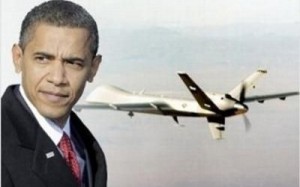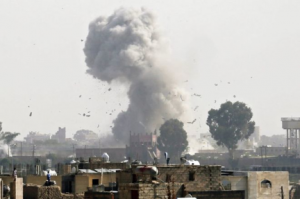|
By Peter Kuznick and Edu Montesanti
From Global Research | Original Article
An Interview with Peter Kuznick
“The United States found a solution to the problem of “collateral damage, by assuming that any male of military age in a war zone is a militant and worthy of execution” says in the following incisive interview the renowned researcher, Professor Doctor Peter Kuznick, Director of the Nuclear Studies Institute at American University, in Washington D.C. Drones “kill women, children, they kill everybody,” Professor Kuznick says.
He observes that odious Obama’s drone warfare was, appears today as the voice of moderation compared to Trump.
As for him, instead of using drones for humans and environment, US drone program is “mostly negative” as Washington is turning them into “killing machines.” Professor Peter Kuznick points out that the matter is not “a choice between drones, manned bombers, and boots on the ground. I see it as a choice between war and diplomacy.”
Edu Montesanti: US government assures that operations with drones are a more precise alternative to boots on the ground, authorized only when an “imminent” threat is present and there is “near certainty” that the intended target will be eliminated. The justification for the use of drones is that they are surgical and precise, and don’t kill civilians. However, the official number of civilians killed by drones is so large, for so long much larger than combatants killed. US drone program have been used as bombs out of regions at war such as Yemen and Somalia, and as surveillance all this mostly in secret by the Washington regime. How do you see US drone program. Professor Doctor Peter Kuznick, how do you see such a “policy” itself, that of substituting boots on the grounds by drones? And how precise are drones?
Prof. Dr. Peter Kuznick: I’m very much opposed to widespread U.S. use of drones, especially outside of declared war zones. I don’t see it as a choice between drones, manned bombers, and boots on the ground. I see it as a choice between war and diplomacy.

There are certainly situations in which diplomacy doesn’t work, but the U.S. has been much too quick to resort to military means to resolve all disputes and problems. Take the case of the U.S. invasion of Afghanistan for example. Yes, the Taliban government in Afghanistan had sheltered Al Qaeda when it planned the attack on 9/11 and the Taliban government was extremely repressive, especially toward women. But has 16 years of U.S.-led war been an improvement? Some Afghans and American defense contractors have gotten rich, but most Afghans have been pretty miserable.
After 9/11, the U.S. insisted that the Afghans turn over the Al Qaeda leaders. On October 15, one week after Operation Enduring Freedom had begun, the Taliban foreign minister offered to turn Osama bin Laden over to the Organization of the Islamic Conference for trial, but the U.S. accused them of stalling. But Milton Bearden, the former CIA station chief who had overseen the 1980s covert war from Pakistan, the Taliban was sincere. “We never heard what they were trying to say,” he insisted. “We had no common language. Ours was ‘give up bin Laden.’ They were saying ‘do something to help us give him up.’” U.S. representatives had met with Taliban leaders more than 20 times the previous three years. Bearden said he had “no doubts they wanted to get rid of him,” but the U.S. was intent on going to war and never offered the face-saving measures the Taliban needed. Since then, Afghanistan has been a playground for U.S. drone warfare, especially after Obama withdrew most of the hundred thousand troops he and Bush had deployed.
But the justification for the use of drones is that they are surgical and precise and don’t kill civilians. President Obama made this case repeatedly when he was in office. Speaking at the University of Chicago Law School in April 2016, he declared, “What I can say with great certainty is that the rate of civilian casualties in any drone operation are far lower than the rate of civilian casualties that occur in conventional war.”
That sounds good, but it’s not true. A 2013 study by Larry Lewis of the Center for Naval Analyses and Sarah Holewinski of the Center for Civilians in Conflict concluded that drone use in Afghanistan caused ten times as many civilian deaths as manned fighter aircraft. In 2016, Micah Zenko and Amelia Mae Wolf of the Council on Foreign Relations reported that “The Obama administration’s assumption that drones cause less collateral damage than piloted aircraft is simply untrue. According to the best publicly available evidence, drone strikes in non-battlefield settings — Pakistan, Yemen, and Somalia — result in 35 times more civilian fatalities than airstrikes by manned weapons systems in conventional battlefields, such as Iraq, Syria, and Afghanistan.”
The real advantage of drones is that they result in far fewer U.S. combat deaths than would manned flights and boots on the ground.
Edu Montesanti: Contrary to Barack Obama, President Donald Trump has given the Central Intelligence Agency new authority to conduct drone attacks against suspected militants. The situations is going to get even worse, isn’t it, Professor Kuznick?
Prof. Dr. Peter Kuznick: As odious as Obama’s use of drone warfare was, he appears as the voice of moderation compared to Trump. Obama had his weekly meetings at which he personally signed off on his “kill lists.” After much criticism, he crafted new rules to limit the harm to civilians. Toward the end of his administration, he didn’t allow drone strikes outside war zones unless there was “near certainty” that civilians wouldn’t be injured, capture of the offenders was “not feasible,” and the target posed an “imminent threat” to the U.S.
Trump, on the other hand, has given carte blanche to his generals. He says he “trusts” his generals to make military decisions and leaves it up to them. As a result, the number of drone strikes has actually risen dramatically since Trump took office.

The Long War Journal reported that in Obama’s last year in office, there were only three drone strikes in Pakistan, down sharply from previous years, and 38 in Yemen. Trump has relaxed the rules Obama instituted and gives the CIA and military much more latitude in targeting Al Qaeda and ISIS in Yemen, Libya, Syria, Somalia, Iraq, and Afghanistan.
As a result, the number of civilian deaths has skyrocketed. Whereas Obama had sharply limited CIA involvement in drone warfare, Trump has expanded the CIA’s role.
Edu Montesanti: How do you see the official version in the US government involving drone “efficient” attacks as they actually kill much more civilians?
Prof. Dr. Peter Kuznick: As I mentioned before, the cavalier attitude sometimes expressed about “collateral damage” is unconscionable. It is obscene. As Archbishop Desmund Tutu said in his letter to the editor of the New York Times, “Do the United States and its people really want to tell those of us who live in the rest of the world that our lives are not of the same value as yours?”
But the United States found a solution to the problem of “collateral damage.” The Obama administration defined the problem out of existence by assuming that any male of military age in a war zone is a militant and worthy of execution in a “signature” strike. In most of these strikes, the U.S. has no way of knowing whether those targeted were terrorists.
These attacks are not only morally objectionable and often illegal, they are also counterproductive. They produce more terrorists than they kill. As Faisal Shahzad, “the Times Square Bomber,” responded to the judge who asked him how he could risk killing innocent children and women, the drone strikes, he said, “don’t see children. They don’t see anybody. They kill women, children, they kill everybody.” Drone operators often dehumanize the victims by referring to them as “bug splats.”
Edu Montesanti: The renowned lawyer Professor Doctor Azadeh Shahshahani, Director for Project South, recently observed to me that:
a) In the domestic (US) context, they be used for artistic or investigative purposes. For example, they can be used to investigate agribusinesses to see if they are engaging in animal abuse or not. In that sense, they can play an important and legitimate role. However, their use needs to be regulated to ensure that they are used for surveillance by law enforcement agencies.
b) Per international humanitarian law, drones can only be used with bombs in an active armed conflict and even then with certain restrictions including military necessity, humanity, distinction, and proportionality. Only combatants or civilians who are directly participating in hostilities may be targeted. Targeting of other civilians is prohibited and may constitute a war crime. How much the US government is respecting these principles, Lisa, using drones both as surveillance and bombs?
Prof. Dr. Peter Kuznick: Like with most scientific and technological innovations, drones can be used for war or peace. They can be used to enrich human life or to destroy it. They represent not only an engine of death in warfare but an engine of surveillance that threatens privacy.
Their potential uses go far beyond making deliveries like Amazon has in mind. They can be used for monitoring the environment, protecting wildlife, and firefighting among other things. The sky, so to speak, is the limit for them. But right now the uses are mostly negative.

They have been turned into killing machines. And, as we’ve learned with nuclear arms and other dangerous weapon systems, once one country has them, others will too. So right now the U.S., Israel, and Britain have been weaponizing them for use in “war zones,” but what’s to stop the Russians from using them to kill Chechins or the Chinese from killing Uighurs? The U.S. approach is very shortsighted if U.S. leaders think they’ll retain a monopoly on this type of warfare.
China, Russia, and Iran also have very advanced systems of predator drones. The face of modern warfare is ugly and about to get uglier. Watch out.
|